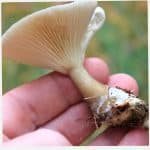The leafy brain fungus (Phaeotremella foliacea) is a rather weird and gross-looking brown jelly mushroom that appears in bunches on dead wood. It’s actually a parasite of another mushroom, showing up to feed on crust fungi. There are two leafy brain fungi species: one grows on deciduous trees and the other on conifers. Other than that, there isn’t much difference (in fact, for a long time, they were thought to be the same). This guide covers both species.
- Scientific Name: Phaeotremella foliacea syn. Tremella foliacea/Phaeotremella frondosa, syn. Tremella frondosa
- Common Names: Leafy Brain, Jelly Leaf, Brown Witch’s Butter
- Habitat: Dead trees where the Stereum crust fungi grow
- Edibility: Edible

Jump to:
All About Leafy Brain Fungus
These mushrooms get their name from their leaf-like, contorted folds that resemble the intricate structure of a brain. Or like fronds of seaweed. Or, a pile of brownish egg noodles, cooked and left on the forest floor. They are often goopy and squishy and don’t look at all like “normal” mushrooms.
Initially, these species were described to science as Tremella foliacea and Tremella frondosa, although some people thought they might be the same species. And, it was complicated to tell them apart if they were two separate species.
In 2015, DNA analysis discovered that these two brown jelly fungi were not actually related to Tremella at all. Instead,they belong to a separate genus, Phaeotremella. And that these two were distinct from each other, with one growing on deciduous trees and the other growing on conifers. Because the name change is relatively recent, you’ll still see these fungi in identification books and online under the old Tremella name.
The scientific names “foliacea” and “frondosa” both mean “leafy,” a reference to the shape of the fruiting bodies.
Both of these leafy brain fungi are parasitic on Stereum crust fungi. Phaeotremella foliacea attacks Stereum sanguinolentum, a crust fungi that grows on dead and recently fallen conifer branches. Phaeotremella frondosa attacks the crust fungi Stereum hirsutum and Stereum rugosum, among others. These crust fungi fruit on recently fallen and dead branches of broadleaf trees.
The leafy brain fungi actually grow from the crust fungi’s hyphae (its mycelial “roots”) rather than from the fruiting body. These

Leafy Brain Fungus Identification Guide
Season
This gelatinous fungus can be found throughout the year but is most visible in fall and winter.
Habitat
The leafy brain fungus is parasitic and grows on dead timber of broadleaf trees and conifers. It’s not the dead timber that the leafy brain fungus consumes, but a kind of bracket or crust fungus that itself has been feeding on the wood. Therefore, it’s classified as a parasitic rather than a saprobic species.
Phaeotremella foliacea attacks a crust fungi that grows on dead and recently fallen conifer branches. Phaeotremella frondosa attacks the crust fungi on recently fallen and dead branches of broadleaf trees.
It’s widely distributed in North America, Europe, and northern Asia.


Identification
Body
The fully developed leafy brain fungus doesn’t have a distinct cap, gills, or stem. Instead, it is a mass of loosely packed, irregularly convoluted folds that resemble lettuce leaves or seaweed fronds. The individual lobes are reddish-brown to dark brown or pale pinkish-brown and can also sometimes appear reddish-orange.
The bodies of these fungi grow up to 3″ across. They are gelatinous and squishy. The flesh is the same color as the surface. When fresh, it’s moist but can shrivel to a hard, dark crust in dry weather conditions.
Leafy brain fungi bodies are smooth without decorations. They might be dry or super moist and shiny. They don’t have a stem, but the individual lobes all originate from a shared point of attachment to the wood.
The overall appearance of the leafy brain varies quite a bit. It can be super gelatinous, with more of a blob-like look and limited distinction between the fronds or folds. Or, in drier weather, the fronds might be clearly defined and separate, looking a lot like seaweed with easily discernible individual arms. Or, a head of ruffled lettuce with closely gathered but easily separated leaves.
It may also look super dark and shriveled – this happens in very dry weather when it is trying to preserve moisture but has already lost a lot. It shrinks down, and the color becomes concentrated and dark.
Odor
The leafy brain fungus does not have a distinctive odor.
Spore Print
The spore print is white.



Leafy Brain Fungus Lookalikes
Amber Jelly Roll (Exidia crenata)
The amber jelly roll is brown like the leafy brain fungus, but it is much darker in color with more red. The amber jelly roll also grows more like an ear or single frond, as opposed to the leafy brains many lettuce-like “leaves.” The leafy brain is much more gelatinous and squishy than the amber jelly.

Witch’s Butter (Tremella mesenterica)
The witches butter fungus is also jelly-like but is bright yellow in color.

Leafy Brain Edibility and Culinary Use
While the leafy brain fungus is technically edible (not toxic), its gelatinous texture and lack of distinct flavor make it less popular in cooking. However, for those with an adventurous palate, it can be a unique addition to soups or stews, offering an interesting texture. It is used regularly in Chinese cooking to add bulk and texture to soups and stir-fries.

Common Questions About Leafy Brain Fungus
Does the leafy brain fungus have medicinal properties?
While the leafy brain fungus is not widely recognized for its medicinal properties, many types of jelly fungi, including those in the Tremella genus, are known for their health benefits in traditional Eastern medicine.









Cliff says
Thanks for the info.